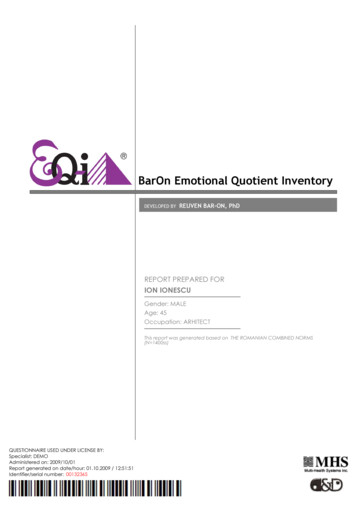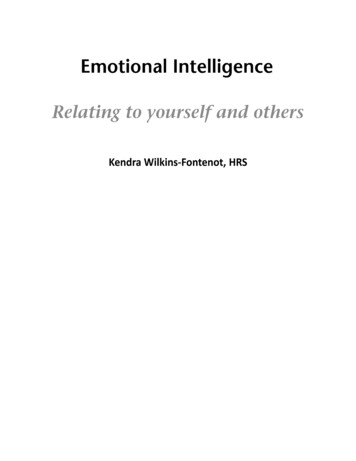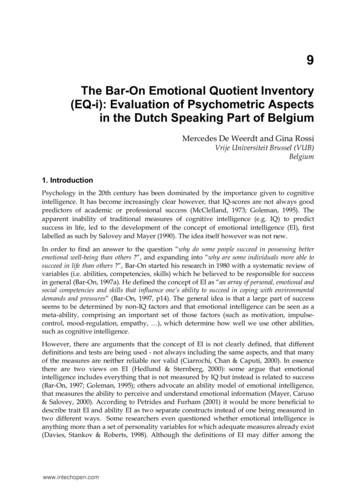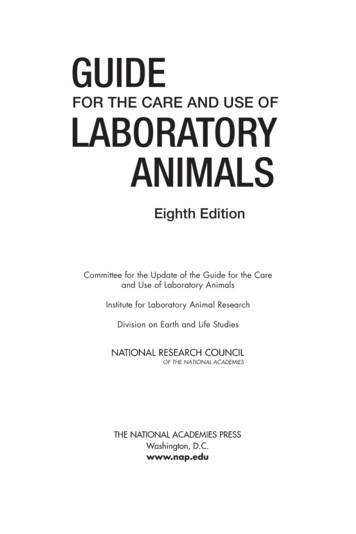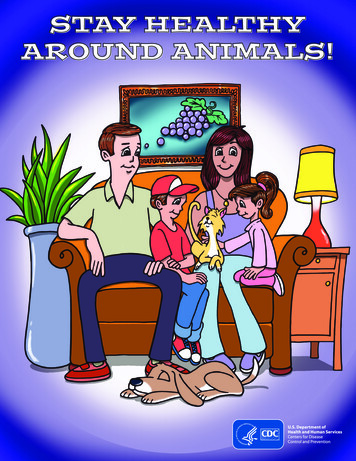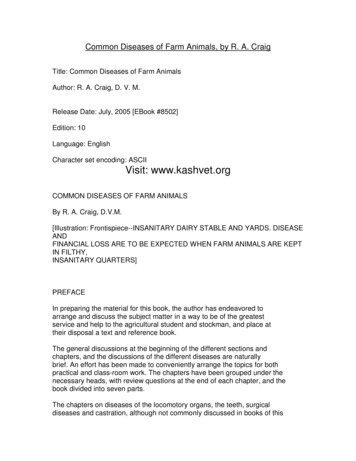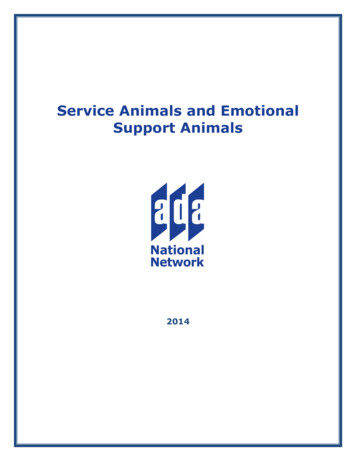
Transcription
Service Animals and EmotionalSupport Animals2014
Service Animals and EmotionalSupport AnimalsWhere are they allowed and under what conditions?Jacquie BrennanVinh Nguyen (Ed.)Southwest ADA CenterA program of ILRU at TIRR Memorial Hermanni
ForewordThis manual is dedicated to the memory ofPax, a devoted guide dog, and to all thehandler and dog teams working togetheracross the nation. Guide dogs make itpossible for their handlers to travel safelywith independence, freedom and dignity.Pax guided his handler faithfully for overten years. Together they negotiatedcountless busy intersections and safelytraveled the streets of many cities, largeand small. His skillful guiding kept his handler from injury on more than oneoccasion. He accompanied his handler to business meetings, restaurants,theaters, and social functions where he conducted himself as would anyhighly-trained guide dog. Pax was a seasoned traveler and was the first dogto fly in the cabin of a domestic aircraft to Great Britain, a country that hadpreviously barred service animals without extended quarantine.Pax was born in the kennels of The Seeing Eye in the beautiful WashingtonValley of New Jersey in March 2000. He lived with a puppy-raiser family foralmost a year where he learned basic obedience and was exposed to thesights and sounds of community life—the same experiences he would soonface as a guide dog. He then went through four months of intensive trainingwhere he learned how to guide and ensure the safety of the person withwhom he would be matched. In November 2001 he was matched with hishandler and they worked as a team until Pax’s retirement in January 2012,after a long and successful career. Pax retired with his handler’s family,where he lived with two other dogs. His life was full of play, long naps, andrecreational walks until his death in January 2014.It is the sincere hope of Pax’s handler that this guide will be useful inimproving the understanding about service animals, their purpose and role,their extensive training, and the rights of their handlers to travel freely andto experience the same access to employment, public accommodations,transportation, and services that others take for granted.ii
I. IntroductionIndividuals with disabilities may use service animals and emotional supportanimals for a variety of reasons. This guide provides an overview of howmajor Federal civil rights laws govern the rights of a person requiring aservice animal. These laws, as well as instructions on how to file acomplaint, are listed in the last section of this publication. Many states alsohave laws that provide a different definition of service animal. You shouldcheck your state’s law and follow the law that offers the most protection forservice animals. The document discusses service animals in a number ofdifferent settings as the rules and allowances related to access with serviceanimals will vary according to the law applied and the setting.II. Service Animal Definedby Title II and Title III of theADAA service animal means any dog that is individually trained to do work orperform tasks for the benefit of an individual with a disability, including aphysical, sensory, psychiatric, intellectual, or other mental disability. Tasksperformed can include, among other things, pulling a wheelchair, retrievingdropped items, alerting a person to a sound, reminding a person to takemedication, or pressing an elevator button.Emotional support animals, comfort animals, and therapy dogs are notservice animals under Title II and Title III of the ADA. Other species ofanimals, whether wild or domestic, trained or untrained, are not consideredservice animals either. The work or tasks performed by a service animalmust be directly related to the individual’s disability. It does not matter if aperson has a note from a doctor that states that the person has a disabilityand needs to have the animal for emotional support. A doctor’s letter doesnot turn an animal into a service animal.Examples of animals that fit the ADA’s definition of “service animal”because they have been specifically trained to perform a task for the personwith a disability:1
· Guide Dog or Seeing Eye Dog1 is a carefully trained dog that serves as atravel tool for persons who have severe visual impairments or are blind.· Hearing or Signal Dog is a dog that has been trained to alert a person whohas a significant hearing loss or is deaf when a sound occurs, such as a knockon the door.· Psychiatric Service Dog is a dog that has been trained to perform tasks thatassist individuals with disabilities to detect the onset of psychiatric episodesand lessen their effects. Tasks performed by psychiatric service animals mayinclude reminding the handler to take medicine, providing safety checks orroom searches, or turning on lights for persons with Post Traumatic StressDisorder, interrupting self-mutilation by persons with dissociative identitydisorders, and keeping disoriented individuals from danger.· SSigDOG (sensory signal dogs or social signal dog) is a dog trained to assista person with autism. The dog alerts the handler to distracting repetitivemovements common among those with autism, allowing the person to stopthe movement (e.g., hand flapping).· Seizure Response Dog is a dog trained to assist a person with a seizuredisorder. How the dog serves the person depends on the person’s needs.The dog may stand guard over the person during a seizure or the dog maygo for help. A few dogs have learned to predict a seizure and warn theperson in advance to sit down or move to a safe place.Under Title II and III of the ADA, service animals are limited to dogs.However, entities must make reasonable modifications in policies to allowindividuals with disabilities to use miniature horses if they have beenindividually trained to do work or perform tasks for individuals withdisabilities.III. Other Support or TherapyAnimalsWhile Emotional Support Animals or Comfort Animals are often used as partof a medical treatment plan as therapy animals, they are not consideredservice animals under the ADA. These support animals providecompanionship, relieve loneliness, and sometimes help with depression,2
anxiety, and certain phobias, but do not have special training to performtasks that assist people with disabilities. Even though some states have lawsdefining therapy animals, these animals are not limited to working withpeople with disabilities and therefore are not covered by federal lawsprotecting the use of service animals. Therapy animals provide people withtherapeutic contact, usually in a clinical setting, to improve their physical,social, emotional, and/or cognitive functioning.IV. Handler’s ResponsibilitiesThe handler is responsible for the care and supervision of his or her serviceanimal. If a service animal behaves in an unacceptable way and the personwith a disability does not control the animal, a business or other entity doesnot have to allow the animal onto its premises. Uncontrolled barking,jumping on other people, or running away from the handler are examples ofunacceptable behavior for a service animal. A business has the right to denyaccess to a dog that disrupts their business. For example, a service dog thatbarks repeatedly and disrupts another patron’s enjoyment of a movie couldbe asked to leave the theater. Businesses, public programs, andtransportation providers may exclude a service animal when the animal’sbehavior poses a direct threat to the health or safety of others. If a serviceanimal is growling at other shoppers at a grocery store, the handler may beasked to remove the animal. The ADA requires the animal to be under the control of the handler. Thiscan occur using a harness, leash, or other tether. However, in cases whereeither the handler is unable to hold a tether because of a disability or itsuse would interfere with the service animal’s safe, effective performanceof work or tasks, the service animal must be under the handler’s control bysome other means, such as voice control.2 The animal must be housebroken.3 The ADA does not require covered entities to provide for the care orsupervision of a service animal, including cleaning up after the animal. The animal should be vaccinated in accordance with state and local laws.3
An entity may also assess the type, size, and weight of a miniature horse indetermining whether or not the horse will be allowed access to the facility.V. Handler’s Rightsa) Public Facilities and AccommodationsTitles II and III of the ADA makes it clear that service animals are allowed inpublic facilities and accommodations. A service animal must be allowed toaccompany the handler to any place in the building or facility wheremembers of the public, program participants, customers, or clients areallowed. Even if the business or public program has a “no pets” policy, itmay not deny entry to a person with a service animal. Service animals arenot pets. So, although a “no pets” policy is perfectly legal, it does not allowa business to exclude service animals.When a person with a service animal enters a public facility or place of publicaccommodation, the person cannot be asked about the nature or extent of hisdisability. Only two questions may be asked:4
1. Is the animal required because of a disability?2. What work or task has the animal been trained to perform?These questions should not be asked, however, if the animal’s service tasks areobvious. For example, the questions may not be asked if the dog is observedguiding an individual who is blind or has low vision, pulling a person’swheelchair, or providing assistance with stability or balance to an individualwith an observable mobility disability.4A public accommodation or facility is not allowed to ask for documentation orproof that the animal has been certified, trained, or licensed as a serviceanimal. Local laws that prohibit specific breeds of dogs do not apply to serviceanimals.5A place of public accommodation or public entity may not ask an individual witha disability to pay a surcharge, even if people accompanied by pets are requiredto pay fees. Entities cannot require anything of people with service animals thatthey do not require of individuals in general, with or without pets. If a publicaccommodation normally charges individuals for the damage they cause, anindividual with a disability may be charged for damage caused by his or herservice animal.6b) EmploymentLaws prohibit employment discrimination because of a disability. Employers arerequired to provide reasonable accommodation. Allowing an individual with adisability to have a service animal or an emotional support animal accompanythem to work may be considered an accommodation. The Equal EmploymentOpportunity Commission (EEOC), whichenforces the employment provisions ofthe ADA (Title I), does not have a specificregulation on service animals.7 In the caseof a service animal or an emotionalsupport animal, if the disability is notobvious and/or the reason the animal isneeded is not clear, an employer mayrequest documentation to establish theexistence of a disability and how theanimal helps the individual perform his or5
her job.Documentation might include a detailed description of how the animal wouldhelp the employee in performing job tasks and how the animal is trained tobehave in the workplace. A person seeking such an accommodation maysuggest that the employer permit the animal to accompany them to work on atrial basis.Both service and emotional support animals may be excluded from theworkplace if they pose either an undue hardship or a direct threat in theworkplace.c) HousingThe Fair Housing Act (FHA) protects a person with a disability fromdiscrimination in obtaining housing. Under this law, a landlord or homeowner’sassociation must provide reasonable accommodation to people with disabilitiesso that they have an equal opportunity to enjoy and use a dwelling.8 Emotionalsupport animals that do not qualify as service animals under the ADA maynevertheless qualify as reasonable accommodations under the FHA.9 In caseswhen a person with a disability uses a service animal or an emotional supportanimal, a reasonable accommodation may include waiving a no-pet rule or apet deposit.10 This animal is not considered a pet.A landlord or homeowner’s association may not ask a housing applicant aboutthe existence, nature, and extent of his or her disability. However, an individualwith a disability who requests a reasonable accommodation may be asked toprovide documentation so that the landlord or homeowner’s association canproperly review the accommodation request.11 They can ask a person to certify,in writing, (1) that the tenant or a member of his or her family is a person with adisability; (2) the need for the animal to assist the person with that specificdisability; and (3) that the animal actually assists the person with a disability. Itis important to keep in mind that the ADA may apply in the housing context aswell, for example with student housing. Where the ADA applies, requiringdocumentation or certification would not be permitted with regard to ananimal that qualifies as a “service animal.”6
d) EducationService animals in public schools (K-12)13 – The ADA permits a student with adisability who uses a service animal to have the animal at school. In addition,the Individuals with Disabilities Education Act (IDEA) and Section 504 of theRehabilitation Act allow a student to use an animal that does not meet the ADAdefinition of a service animal if that student’s Individual Education Plan (IEP) orSection 504 team decides the animal is necessary for the student to receive afree and appropriate education. Where the ADA applies, however, schoolsshould be mindful that the use of a service animal is a right that is notdependent upon the decision of an IEP or Section 504 team.14Emotional support animals, therapy animals, and companion animals areseldom allowed to accompany students in public schools. Indeed, the ADA doesnot contemplate the use of animals other than those meeting the definition of“service animal.” Ultimately, the determination whether a student may utilizean animal other than a service animal should be made on a case-by-case basisby the IEP or Section 504 team.Service animals in postsecondary education settings – Under the ADA, collegesand universities must allow people with disabilities to bring their serviceanimals into all areas of the facility that are open to the public or to students.Colleges and universities may have a policy asking students who use service7
animals to contact the school’s Disability Services Coordinator to register as astudent with a disability. Higher education institutions may not require anydocumentation about the training or certification of a service animal. They may,however, require proof that a service animal has any vaccinations required bystate or local laws that apply to all animals.e) TransportationA person traveling with a service animal cannot be denied access totransportation, even if there is a “no pets” policy. In addition, the person with aservice animal cannot be forced to sit in a particular spot; no additional fees canbe charged because the person uses a service animal; and the customer doesnot have to provide advance notice that s/he will be traveling with a serviceanimal.The laws apply to both public and private transportation providers and includesubways, fixed-route buses, Paratransit, rail, light-rail, taxicabs, shuttles andlimousine services.f) Air TravelThe Air Carrier Access Act (ACAA) requires airlines to allow service animals andemotional support animals to accompany their handlers in the cabin of theaircraft.Service animals – For evidence that an animal is a service animal, air carriersmay ask to see identification cards, written documentation, presence ofharnesses or tags, or ask for verbal assurances from the individual with adisability using the animal. If airline personnel are uncertain that an animal is aservice animal, they may ask one of the following:1. What tasks or functions does your animal perform for you?2. What has your animal been trained to do for you?3. Would you describe how the animal performs this task for you? 15Emotional support and psychiatric service animals – Individuals who travelwith emotional support animals or psychiatric service animals may need toprovide specific documentation to establish that they have a disability and thereason the animal must travel with them. Individuals who wish to travel withtheir emotional support or psychiatric animals should contact the airline ahead8
of time to find out what kind of documentation is required.Examples of documentation that may be requested by the airline: Currentdocumentation (not more than one year old) on letterhead from a licensedmental health professional stating (1) the passenger has a mental healthrelated disability listed in the Diagnostic and Statistical Manual of MentalDisorders (DSM IV); (2) having the animal accompany the passenger isnecessary to the passenger’s mental health or treatment; (3) the individualproviding the assessment of the passenger is a licensed mental healthprofessional and the passenger is under his or her professional care; and (4) thedate and type of the mental health professional’s license and the state or otherjurisdiction in which it was issued.16 This documentation may be required as acondition of permitting the animal to accompany the passenger in the cabin.Other animals – According to the ACAA, airlines are not required otherwise tocarry animals of any kind either in the cabin or in the cargo hold. Airlines arefree to adopt any policy they choose regarding the carriage of pets and otheranimals (for example, search and rescue dogs) provided that they comply withother applicable requirements (for example, the Animal Welfare Act).Animals such as miniature horses, pigs, and monkeys may be consideredservice animals. A carrier must decide on a case-by-case basis according tofactors such as the animal’s size and weight; state and foreign countryrestrictions; whether or not the animal would pose a direct threat to the healthor safety of others; or cause a fundamental alteration in the cabin service.17Individuals should contact the airlines ahead of travel to find out what ispermitted.Airlines are not required to transport unusual animals such as snakes, otherreptiles, ferrets, rodents, and spiders. Foreign carriers are not required totransport animals other than dogs.18VI. Reaction/Response ofOthersAllergies and fear of dogs are not valid reasons for denying access or refusingservice to people using service animals. If employees, fellow travelers, or9
customers are afraid of service animals, a solution may be to allow enoughspace for that person to avoid getting close to the service animal.Most allergies to animals are caused by direct contact with the animal. Aseparated space might be adequate to avoid allergic reactions.If a person is at risk of a significant allergic reaction to an animal, it is theresponsibility of the business or government entity to find a way toaccommodate both the individual using the service animal and the individualwith the allergy.VII. Service Animals inTraininga) Air TravelThe Air Carrier Access Act (ACAA) does not allow “service animals in training” inthe cabin of the aircraft because “in training” status indicates that they do notyet meet the legal definition of service animal. However, like pet policies, airlinepolicies regarding service animals in training vary. Some airlines permitqualified trainers to bring service animals in training aboard an aircraft fortraining purposes. Trainers of service animals should consult with airlines andbecome familiar with their policies.b) EmploymentIn the employment setting, employers may be obligated to permitemployees to bring their “service animal in training” into the workplace as areasonable accommodation, especially if the animal is being trained toassist the employee with work-related tasks. The untrained animal may beexcluded, however, if it becomes a workplace disruption or causes an unduehardship in the workplace.c) Public Facilities and AccommodationsTitle II and III of the ADA does not cover “service animals in training” butseveral states have laws when they should be allowed access.10
VIII. Laws & Enforcementa) Public Facilities and AccommodationsTitle II of the ADA covers state and local government facilities, activities, andprograms. Title III of the ADA covers places of public accommodations.Section 504 of the Rehabilitation Act covers federal government facilities,activities, and programs. It also covers the entities that receive federalfunding.Title II and Title III Complaints – These can be filed through private lawsuitsin federal court or directed to the U.S. Department of Justice.U.S. Department of Justice950 Pennsylvania Avenue, N.W.Civil Rights DivisionDisability Rights Section – NYAWashington, DC 20530http://www.ada.gov800-514-0301 (v)800-514-0383 (TTY)Section 504 Complaints – These must be made to the specific federalagency that oversees the program or funding.b) EmploymentTitle I of the ADA and Section 501 and Section 504 of the Rehabilitation Actprohibits discrimination in employment. The ADA covers private employerswith 15 or more employees; Section 501 applies to federal agencies, andSection 504 applies to any program or entity receiving federal financialassistance.ADA Complaints - A person must file a charge with the Equal EmploymentOpportunity Commission (EEOC) within 180 days of an alleged violation ofthe ADA. This deadline may be extended to 300 days if there is a state orlocal fair employment practices agency that also has jurisdiction over thismatter. Complaints may be filed in person, by mail, or by telephone bycontacting the nearest EEOC office. This number is listed in most telephonedirectories under “U.S. Government.” For more 1
800-669-4000 (voice)800-669-6820 (TTY)Section 501 Complaints - Federal employees must contact their agency’sEqual Employment Opportunity (EEO) officer within 45 days of an allegedSection 501 violation.Section 504 Complaints – These must be filed with the federal agency thatfunded the employer.c) HousingThe Fair Housing Act (FHA), as amended in 1988, applies to housing. Section504 of the Rehabilitation Act of 1973 prohibits discrimination on the basis ofdisability in all housing programs and activities that are either conducted bythe federal government or receive federal financial assistance. Title II of theADA applies to housing provided by state or local government entities.Complaints – Housing complaints may be filed with the Department ofHousing and Urban Development (HUD) Office of Fair Housing and -669-9777 (voice)800-927-9275 (TTY)d) EducationStudents with disabilities in public schools (K-12) are covered by Individualswith Disabilities Education Act (IDEA), Title II of the ADA, and Section 504 ofthe Rehabilitation Act. Students with disabilities in public postsecondaryeducation are covered by Title II and Section 504. Title III of the ADA appliesto private schools (K-12 and post-secondary) that are not operated byreligious entities. Private schools that receive federal funding are alsocovered by Section 504.IDEA Complaints - Parents can request a due process hearing and a reviewfrom the state educational agency if applicable in that state. They also canappeal the state agency’s decision to state or federal court. You maycontact the Office of Special Education and Rehabilitative Services (OSERS)for further information or to provide your own thoughts and ideas on how12
they may better serve individuals with disabilities, their families and theircommunities.For more information contact:Office of Special Education and Rehabilitative ServicesU.S. Department of Education400 Maryland Avenue, S.W.Washington, DC 20202-7100202-245-7468 (voice)Title II of the ADA and Section 504 Complaints - The Office for Civil Rights(OCR) in the Department of Education enforces Title II of the ADA andSection 504 as they apply to education. Those who have had access denieddue to a service animal may file a complaint with OCR or file a privatelawsuit in federal court. An OCR complaint must be filed within 180 calendardays of the date of the alleged discrimination, unless the time for filing isextended for good cause. Before filing an OCR complaint against aninstitution, an individual may want to find out about the institution’sgrievance process and use that process to have the complaint resolved.However, an individual is not required by law to use the institutionalgrievance process before filing a complaint with OCR. If someone uses aninstitutional grievance process and then chooses to file the complaint withOCR, the complaint must be filed with OCR within 60 days after the last actof the institutional grievance process.For more information contact:U.S. Department of EducationOffice for Civil Rights400 Maryland Avenue, S.W.Washington, DC 20202-1100Customer Service: 800-421-3481 (voice)800-877-8339 (TTY)E-mail: r/docs/howto.htmlTitle III Complaints – These may be filed with the Department of Justice.U.S. Department of Justice950 Pennsylvania Avenue, N.W.13
Civil Rights DivisionDisability Rights Section – NYAWashington, DC 20530http://www.ada.gov/800-514-0301 (v)800-514-0383 (TTY)e) TransportationTitle II of the ADA applies to public transportation while Title III of the ADAapplies to transportation provided by private entities. Section 504 of theRehabilitation Act applies to federal entities and recipients of federalfunding that provide transportation.Title II and Section 504 Complaints – These may be filed with the FederalTransit Administration’s Office of Civil Rights. For more information,contact:Director, FTA Office of Civil RightsEast Building – 5th Floor, TCR1200 New Jersey Ave., S.E.Washington, DC 20590FTA ADA Assistance Line: 888-446-4511 (Voice)800-877-8339 (Federal Information Relay Service)http://www.fta.dot.gov/civil rights.htmlhttp://www.fta.dot.gov/12874 3889.html (Complaint Form)Title III Complaints – These may be filed with the Department of Justice.U.S. Department of Justice950 Pennsylvania Avenue, N.W.Civil Rights DivisionDisability Rights Section – NYAWashington, DC 20530http://www.ada.gov800-514-0301 (v)800-514-0383 (TTY)Note: A person does not have to file a complaint with the respective federalagency before filing a lawsuit in federal court.14
f) Air TransportationThe Air Carrier Access Act (ACAA) covers airlines. Its regulations clarify whatanimals are considered service animals and explain how each type of animalshould be treated.ACAA complaints may be submitted to the Department of Transportation’sAviation Consumer Protection Division. Air travelers who experiencedisability-related air travel service problems may call the hotline at 800-7784838 (voice) or 800- 455-9880 (TTY) to obtain assistance. Air travelers whowould like the Department of Transportation (DOT) to investigate acomplaint about a disability issue must submit their complaint in writing orvia e-mail to:Aviation Consumer Protection DivisionAttn: C-75-DU.S. Department of Transportation1200 New Jersey Ave, S.E.Washington, DC 20590For additional information and questions about your rights under any ofthese laws, contact your regional ADA center at 800-949-4232 (voice/TTY).15
AcknowledgementsThe contents of this booklet were developed by the Southwest ADA Centerunder a grant (#H133A110027) from the Department of Education’sNational Institute on Disability and Rehabilitation Research (NIDRR).However, those contents do not necessarily represent the policy of theDepartment of Education and you should not assume endorsement by theFederal Government.Southwest ADA Center at ILRUTIRR Memorial Hermann Research Center1333 Moursund St.Houston, Texas 77030713.520.0232 (voice/TTY)800.949.4232 (voice/TTY)http://www.southwestada.orgThe Southwest ADA Center is a program of ILRU (Independent LivingResearch Utilization) at TIRR Memorial Hermann. The Southwest ADACenter is part of a national network of ten regional ADA Centers thatprovide up-to-date information, referrals, resources, and training on theAmericans with Disabilities Act (ADA). The centers serve a variety ofaudiences, including businesses, employers, government entities, andindividuals with disabilities. Call 1-800-949-4232 v/tty to reach the centerthat serves your region or visit http://www.adata.org.This book is printed courtesy of the ADA National Network. The SouthwestADA Center would like to thank Jacquie Brennan (author), Ramin Taheri,Richard Petty, Kathy Gips, Sally Weiss, Wendy Strobel Gower, Erin MarieSember-Chase, Marian Vessels, and the ADA Knowledge Translation Centerat the University of Washington for their contributions to this booklet. Southwest ADA Center 2014. All rights reservedPrincipal Investigator: Lex FriedenProject Director: Vinh NguyenPublication staff: Maria DelBosque, Marisa Demaya, and George Powers16
[1] http://www.seeingeye.org[2] 28 C.F.R. 36.302(c)(4); 28 C.F.,R. § 35.136(d).[3] 28 C.F.R. 36.302(c)(2); 28 C.F.,R. §35.136(b)(2).[4] 28 C.F.R. 36.302(c)(6).[5] See 28 C.F.R. Pt. 35, App. A; Sak v. Aurelia, City of, C 11-4111-MWB (N.D.Iowa Dec. 28, 2011)[6] 28 C.F.R. 36.302(c)(8).[7] 29 C.F.R. Pt. 1630 App. The EEOC, in the Interpretive Guidanceaccompanying the regulations, stated that guide dogs may be anaccommodation.”For example, it would be a reasonable accommodationfor an employer to permit an individual who is blind to use a guide dog atwork, even though the employer would not be required to provide a guidedog for the employee.”[8] 42 U.S.C. § 3604(f)(3)(B).[9] Fair Housing of the Dakotas, Inc. v. Goldmark Prop. Mgmt
· Guide Dog or Seeing Eye Dog1 is a carefully trained dog that serves as a travel tool for persons who have severe visual impairments or are blind. · Hearing or Signal Dog is a dog that has been trained to alert a person who has a significant hearing loss or

